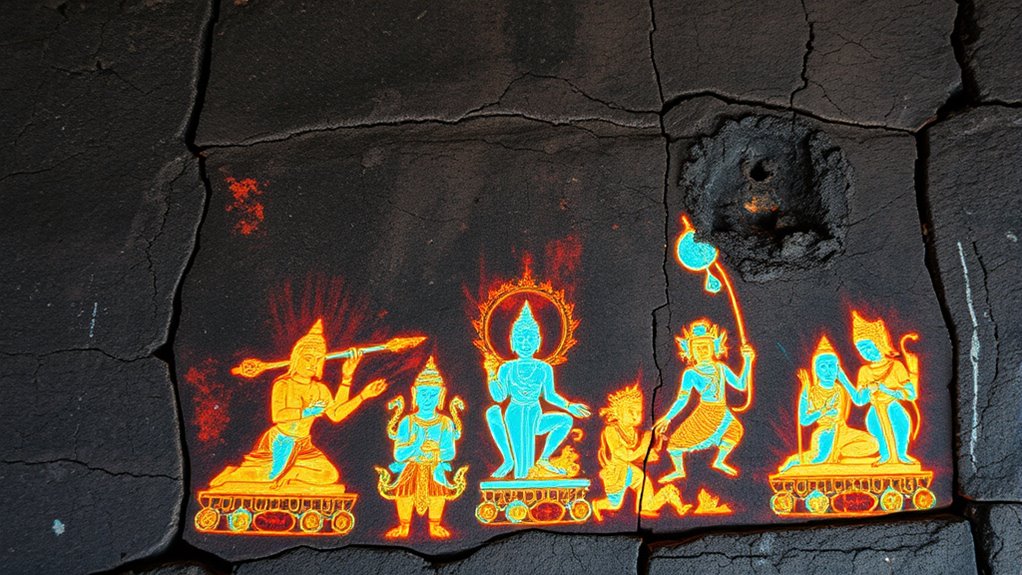Infrared imaging reveals hidden murals inside Angkor Wat, uncovering centuries-old paintings that had faded or been obscured. This technology allows you to see detailed religious scenes, deities, and spiritual symbols without damaging the delicate surfaces. It helps preserve the temple’s original artistry and offers fresh insights into Khmer culture and religious practices. By exploring these discoveries, you’ll gain a new appreciation for ancient craftsmanship and the ongoing efforts to protect this incredible site.
Key Takeaways
- Infrared imaging uncovered previously hidden murals inside Angkor Wat, revealing intricate religious scenes and deities.
- The technique allows non-invasive visualization of faded or damaged artwork beneath layers of grime and overpainting.
- Newly revealed paintings provide insights into ancient Khmer artistic practices and spiritual symbolism.
- Infrared scans aid in preservation, mapping the location and condition of fragile interior murals without physical contact.
- These discoveries enhance understanding of Angkor Wat’s historical and cultural significance, showcasing the temple’s original grandeur.

Thanks to infrared imaging, archaeologists have uncovered previously hidden paintings within Angkor Wat, revealing new insights into its ancient artistry. These discoveries shed light on the intricate techniques used by ancient artists and offer a deeper understanding of the temple’s historical significance. Infrared technology allows you to see beneath layers of grime, overpainting, and damage that have obscured the original artwork for centuries. This method highlights the value of modern preservation techniques in releasing the secrets of ancient art that might otherwise remain concealed.
Infrared imaging reveals hidden Angkor Wat paintings, unveiling ancient artistry and techniques long concealed beneath layers of grime and overpainting.
As you explore the newly revealed murals, you realize how much they contribute to our knowledge of Khmer civilization. These paintings, once hidden, depict religious stories, deities, and celestial beings, illustrating the rich cultural and spiritual life of the time. The ability to recover these images demonstrates how advanced preservation techniques can restore fragments of history, helping you appreciate the craftsmanship and religious symbolism embedded in the art. It’s fascinating to see how technology bridges the gap between the past and present, enabling you to witness the original colors and details that have faded over centuries.
Infrared imaging is a key tool in conserving Angkor Wat’s delicate interior. By non-invasively scanning the walls, conservators can map out the location and condition of hidden paintings without risking further damage. This approach exemplifies responsible preservation techniques that respect the integrity of the site. It allows you to study the art in situ, preserving its context and connection to the architecture, which is essential for understanding its full cultural relevance. With each discovery, you gain a more detailed picture of the artistic practices and religious beliefs that shaped the Khmer Empire.
The uncovering of these paintings also highlights the importance of ongoing preservation efforts. Without the use of such advanced imaging, these artworks might have remained lost forever, eroded by time and the elements. It’s a testimony to how combining ancient art with cutting-edge preservation techniques can rejuvenate historical sites, making their stories accessible to future generations. As you walk through Angkor Wat, you’re reminded that every brushstroke and pigment has survived through centuries, thanks to diligent conservation work. These hidden paintings, once invisible, now enrich your experience, offering a rare glimpse into the artistic mastery and spiritual depth of the ancient Khmer civilization.
Frequently Asked Questions
How Long Do Infrared Imaging Techniques Take to Reveal Hidden Paintings?
You wonder how long infrared imaging techniques take to reveal hidden paintings. The imaging duration depends on the size of the area and the technique’s efficiency. Typically, scanning small sections might take a few minutes, while larger areas could require hours. The process is quite efficient, allowing rapid detection of underlying artwork. Overall, with proper planning, infrared imaging can quickly and effectively uncover hidden features without lengthy delays.
Are All Sections of Angkor Wat Suitable for Infrared Imaging?
You should know that not all sections of Angkor Wat are suitable for infrared imaging due to structural limitations and environmental factors. Some areas might have thick walls, moisture, or damage that hinder clear imaging. Additionally, environmental conditions like weather, temperature, and light levels can affect the process. These factors can make it challenging to capture accurate images everywhere, so experts carefully select the most promising spots for infrared scans.
What Are the Conservation Implications of Uncovering These Hidden Artworks?
Uncovering hidden artworks is like opening a treasure chest, revealing secrets of the past. You need to contemplate conservation implications carefully, balancing restoration ethics with preserving cultural heritage. Revealing these paintings offers valuable insights but also risks damage if not handled responsibly. You must prioritize minimal intervention, ensuring that future generations can appreciate these discoveries without compromising their historical integrity. Preservation demands respect and careful planning.
Can Infrared Imaging Detect Damage or Deterioration Behind Paintings?
You might wonder if infrared imaging can detect damage or deterioration behind paintings. While it’s a useful tool, infrared has limitations, especially with certain materials or thick layers, which can obscure the view. In a historical context, it helps reveal underlying issues without causing harm. However, you should remember that infrared isn’t perfect; it offers insights but sometimes misses subtle damage, requiring complementary techniques for a complete assessment.
Will These Discoveries Influence Future Restoration Projects at Angkor Wat?
This discovery is like opening a treasure chest, revealing secrets that could shape future restoration efforts. You’ll see how understanding the paintings’ original vibrancy influences decisions, ensuring the site’s cultural significance remains intact. These findings might boost tourism impact by attracting more visitors enthusiastic to witness restored masterpieces. Future projects will likely incorporate infrared insights, helping preserve Angkor Wat’s legacy while respecting its historical and cultural importance.
Conclusion
As you step closer, the ancient stone whispers its secrets, revealing vivid colors and intricate scenes hidden beneath centuries of grime. Infrared imaging uncovers a world of artistry, like peering through a veil into a vibrant, forgotten past. You can almost feel the cool touch of history under your fingertips, as these hidden paintings come alive in a burst of radiant hues. It’s a breathtaking glimpse into Angkor Wat’s soul, forever preserved beneath the surface.









